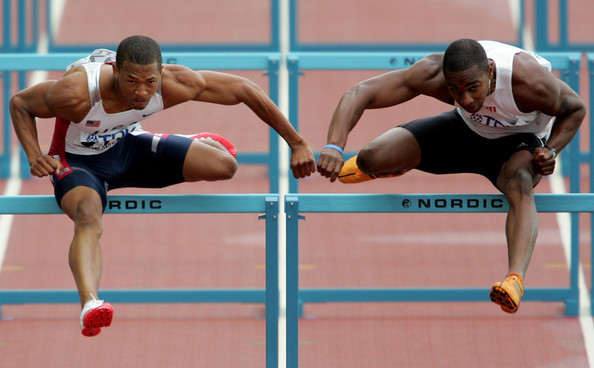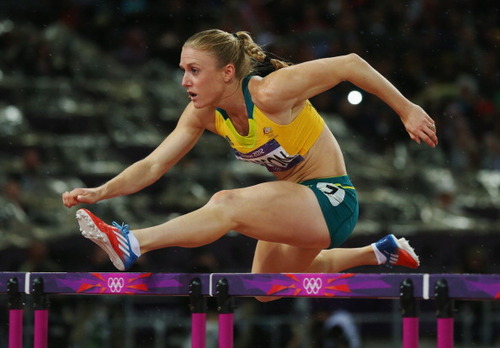Raise ‘Em Up (Part II)
In an article that I wrote back in 2005 entitled “Raise ‘Em Up,” I argued that the height of the hurdles in the women’s 100 meter hurdle race needed to be raised from 33 inches to 36 inches for collegiate and international competition. In that article I argued that the women’s race allows for too many technical flaws and that it favors sprinters over hurdlers. In this article, I will expand on the views I expressed in that article. And I will also compare the women’s race to the men’s race as a means of pointing out how the argument in favor of raising the hurdles isn’t as cut and dry as it seems.
As I noted in the earlier article, the women’s 100m hurdle race used to be only 80 meters, over 30-inch hurdles, until after the 1968 Olympics. Since that time, female athletes have gotten much faster and much stronger. More than forty years have passed, and the level of athleticism has improved dramatically. The 33-inch barriers no longer present a significant challenge to the modern female hurdler.
If you’ve been to a meet and watched the women hurdling, followed by the men hurdling directly afterward, you have noticed the disparities between the two races. The men’s 110H race and the women’s 100H race are so different that they’re barely comparable.
[am4show not_have=”g5;”]
[/am4show][am4guest]
[/am4guest][am4show have=”g5;”]
An argument in favor of keeping the women’s hurdles at their current height is that the women’s race is much more aesthetically pleasing. The men’s race, in many cases, is more spectacle than sport, at least to non-hurdlers. They watch the men’s race not just to see who will win, but to see who will crash and burn, to see hurdles slamming to the track and bouncing in the air. A lot of the time, when people watch men hurdling, they can’t imagine why anyone would voluntarily sign up to run that event. It looks like a disaster waiting to happen. And then it happens.
But in the women’s race, crash-and-burns are much rarer, there are hardly ever hurdles bouncing into the air, and it’s more of a speed race. As a general population, we like speed races, we understand speed races. The men’s race is so technical that it’s arguably more comparable to events like the triple jump and long jump than it is to the 100 meter dash. Although speed is a key factor in the men’s race, you can’t safely predict a 110 hurdler’s hurdle time based on his 100 meter time. Of course, a hurdler with an 11-flat 100 time can’t run 13-flat in the hurdles, but still, the race doesn’t necessarily go to the swiftest. Technique is paramount. So is flexibility. Male hurdlers have to be able to explode into position, they have to be able to contort their bodies.
With the women’s race, on the other hand, 100 meter times serve as a very good indicator of 100 meter hurdle potential. At the high school level, there’s generally going to be a 2-second difference. If your 100 time is 13.0, your 100 hurdle time will be around 15.0. And you can’t hope to run 14.5 unless you get your 100 time down to 12.5. At the top end of the high school level, and then at the collegiate and international levels, this gap will close – down to about a 1.1 or 1.2 difference – but it still serves as a good indicator. The women, even smaller women, can step over the hurdles. They can swing their arms across their body, allow their trail leg to lag behind, lock the knee of the lead leg, twist their hips, and still run lightning-fast times as long as they have great sprint speed and an aggressive mindset.
My observation has been that most hurdle coaches prefer coaching the women’s race for the reasons stated above. Put simply, it’s an easier event to coach. Get the women faster, get them stronger, and they’ll run faster hurdle times. With the men, technical decisions must be made and re-evaluated on a regular basis. Speed causes as many problems as it fixes.
 In this 2005 photo, Joel Brown (left) and Dudley Dorival demonstrate the types of contortionist positions male hurdlers must execute over the 42-inch barriers (photo courtesy zimbio.com)
In this 2005 photo, Joel Brown (left) and Dudley Dorival demonstrate the types of contortionist positions male hurdlers must execute over the 42-inch barriers (photo courtesy zimbio.com)
Quick anecdote: Two summers ago I was getting a female hurdler ready for New Balance Outdoor Nationals that were to take place the third weekend of June. She signed up to run in the Emerging Elite division. If you’re not familiar with the meet, most races have a Championship division and an Emerging Elite division. The Championship division is basically the A Team, and the Emerging Elite division is the B Team. So she signed up to run on the B Team. But Junior Nationals were also being held that weekend, so a lot of the best athletes decided to compete at that meet instead. Which meant that my girl got moved up from the B Team to the A Team. We found out the week of the meet.
Up to that point, I had been planning to train through the meet in preparation for the Junior Olympic Nationals at the end of July. I’d been working steadily on her various flaws – a wide trail leg, wide arms, a tilt in the hips, a locked-knee lead leg. But once getting the news that she was running in the Championship division, I put the brakes on all of that. “Just focus on snapping down your lead leg,” I told her. And that’s all we focused on in practice the next couple days.
At the race, she dropped her personal best by .15 and sniffed making the finals. I was shocked. I had abandoned my own philosophy of being meticulous and patient and had just gone for the quick fix, and she had gone out and blasted her pr. I found myself thinking, and I still find myself thinking, that when it comes to coaching female hurdlers, I should place more emphasis on speed development and less emphasis on technical details.
So it comes down to a simple question: do we want the hurdling events to favor the sprinters or to favor the hurdlers? In a recent interview with www.spikesmag.com, 2012 Olympic 100 meter hurdle champion Sally Pearson of Australia argued that the women’s hurdles should be raised to 36 inches “to get rid of the sprinters and keep the technicians in.” Similarly, in the same article, 400 meter hurdler Eilidh Child of Great Britain argued that the hurdles in that event should be raised a click because “that would mean that the hurdling element would become of greater importance.”
 Sally Pearson is all for raising the height of the hurdles (photo courtesy spikes-mag.tumblr.com).
Sally Pearson is all for raising the height of the hurdles (photo courtesy spikes-mag.tumblr.com).
Pearson’s and Child’s view pretty much mirrors mine. But I would argue that raising the hurdles wouldn’t get rid of the sprinters; it would expose them and force them to address their technical flaws, which would enhance the event.
On the other hand, if we want the hurdling events to favor the sprinters, then the women’s race is fine as it is, and the men’s race should be the one we’re talking about adjusting. At the high school level, lower them to 36 inches, and at the collegiate and international levels lower them to 39. And space them further apart so that the athletes can get their knees up higher in between. There’d be less hurdle crashing, times would get ridiculously fast, and the general population that gets high on sprint races will enjoy the 110 hurdles as much as they enjoy the 100 meter dash. Think about it: Pearson, Brianna Rollins, and Lolo Jones are just as popular and well-known as Shelly Anne-Fraser and Carmelita Jeter, if not more so. But Aries Merritt with his record-shattering 12.80 isn’t even remotely as popular as Usain Bolt. Of course, Bolt’s charismatic, magnetic personality has a lot to do with that, but still, you get the point. Hurdling purists may want the women’s hurdles to be raised, but I’m not sure that the larger track population would agree. And I know that hurdle crews at meets wouldn’t.
Ironically, hurdle purists feel that raising the height of the women’s hurdles would enhance the appeal of the hurdling events. Child said, regarding the 400 hurdles, that “making the event more technical would make it more exciting.” In The Hurdler’s Bible 2, long-time hurdling guru Wilbur Ross argues that raising the women’s hurdles “would make it a more demanding and exciting event” (307). So it seems that hurdlers and non-hurdlers have conflicting ideas of what constitutes “exciting.” To a hurdling purist, exciting means seeing a well-executed hurdle race with athletes exhibiting technical precision between and over the barriers. To the non-purist, at least as it seems to me, exciting means faster. So, if raising the hurdles means that hurdlers who have been running in the 12.30-12.50 range will now be running in the 12.80-13.00 range, I don’t think the general public will go for that, and I doubt that people will understand that 12.80 over 36-inch hurdles is actually faster than 12.50 over 33 inch hurdles. They’ll just see that the times are slower.
Still, despite the ignorance of the general public, I still say raise the hurdles. Ross argues the point very well, so I’ll quote him directly, keeping in mind that he wrote this way back in 1997:
“As it stands now, the women’s hurdles are too low and therefore do not accommodate to the best technical form. Since our women are faster and stronger, and have the advantage of better tracks, shoes and coaching, we should do all we can to encourage them to utilize their abilities to a higher level than ever before. We believe that our women would welcome the challenge” (307).
Ross contends that the hurdles should be raised six inches, to 39 inches (the same height as the male high school height), and that the race should be lengthened to 110 meters (the same length as the men’s race). I don’t know about all that, but I definitely agree with his line of thinking. Challenge the women to be hurdlers like the men are challenged to be hurdlers. As Ross states, “Women have proven that they can perform difficult gymnastic contortions and fly on the uneven parallel bars with the strength and agility they exhibit, now they are pole vaulting” (307). And sixteen years after the publication of the second edition of Ross’ magnum opus, women are pole vaulting very high.
As Ross implies, adjusting to a 3-inch raise in height would not be difficult for female hurdlers, not with the level of athleticism we’re seeing nowadays. If you ask me, there are plenty of high school hurdlers who would have no problem clearing the 36-inch barriers in a race. Which reminds me, since the men must adjust from 39 to 42 when they enter college, it only makes sense that the women would have to make a commensurate adjustment from 33 to 36.
As for the world record issue, as long as the shift is made following an Olympic year, the athletes would have plenty of time to adjust to the higher height prior to the next Olympic Games, and there will be a clear chronological line drawn between “back in the day” of 33 inch hurdles and the “current” height of 36.
***
References:
Ross, Wilbur L and Norma Hernandez de Ross, PH.D. The Hurdler’s Bible 2. 1997. Print.
“Should the Women’s Hurdles Be Raised?” Spikesmag.com. 13 July 2013. Web. 04 Nov. 2013. http://spikes-mag.tumblr.com/post/55692939440/should-the-womens-hurdles-be-raised
[/am4show]
